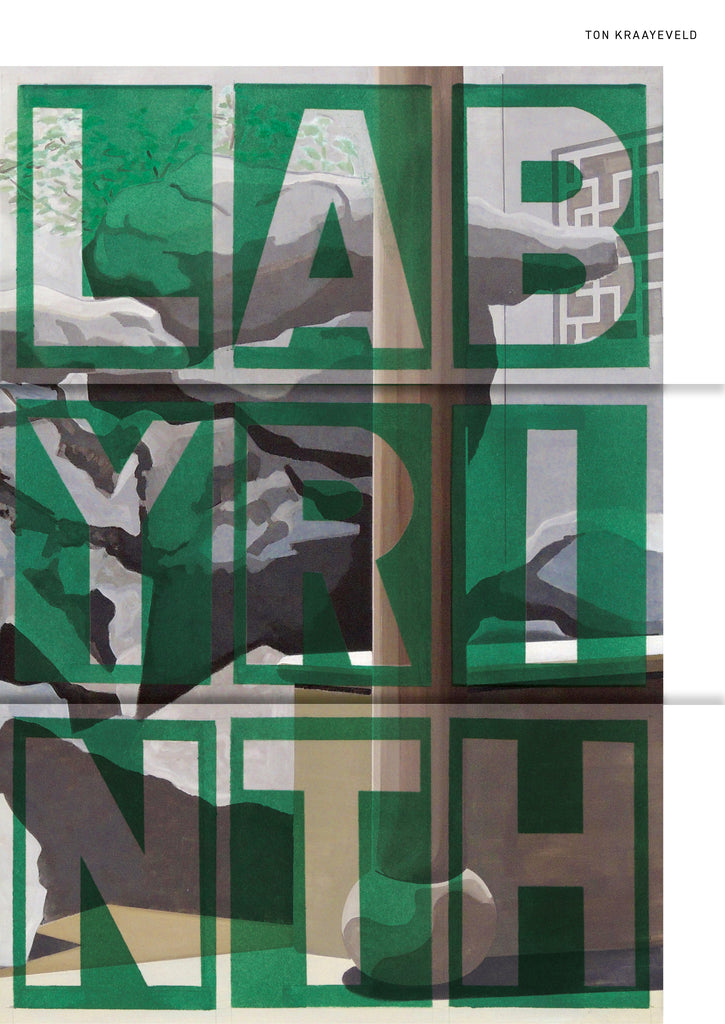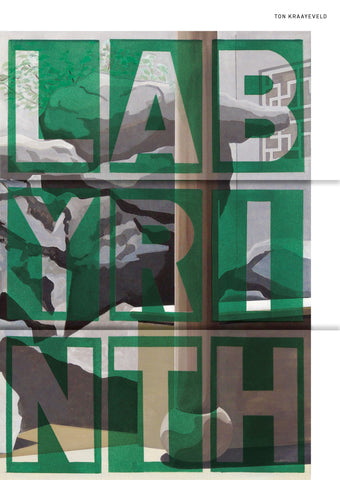Your cart is currently empty!
Labyrinth. Ton Kraayeveld
++++++
+++Ton Kraayeveld+++
+++
'I think a work of art is something different than an opinion, but that it should be able, in its complexity and layeredness, to pose questions or raise issues.'
- Ton Kraayeveld
Labyrinth is an exploration into Ton Kraayeveld's 'network in space and time'. The opening contribution by Bertus Pieters guides us through Kraayeveld's oeuvre, his relationship to Modernism, the influence of his daily experiences and a net of well-known historical figures. A collection of exemplary paintings is accompanied by selected questions from an interview by Marie Jeanne de Rooij. Each question giving an opportunity to reflect, uncover and peak into the labyrinth of his oeuvre. Following is a text by Niek van Vugt and Madeleine Steigenga, admirers and collectors of his work. Ge van Steenbergen then briefly discusses a small green painting before a final contribution by Katja Diallo who explores the ever-constant presence of Franz Kafka throughout Kraayeveld's works.
Connected with each other, the paintings and drawings by Ton K. stare at the audience, inviting it to enter his world where time and space are flexible and visual anachronism is normal. Each painting is a protest against forgetting, in which fragmentation and simultaneity merge. His work is less about the act of painting than about the painting itself as a bearer of images or meanings. Abstraction and figuration coincide, always deriving from reality and giving his paintings a stronger unity and coherence, a new-found layeredness. For Kraayeveld, a painting has to invite the viewer to see it from several perspectives, levels and interpretations. A new challenging tension is introduced by a shift from a literary to a more implicit political subject matter.
'I want a painting to offer itself generously to that imaginary viewer'
- Ton Kraayeveld
Ton Kraayeveld (1955) is a Dutch visual artist who now lives and works in Dordrecht. He graduated in 1985 from the Willem de Kooning Academie in Rotterdam. His oeuvre contains lots of patterns and symbols. His life and experiences, such as many artist-in-residencies influence his work, providing him with new insights and themes. As a protest against the passing of time, he uses paint and manipulated images of visual history, placing them into different contexts. Distilled autobiographical experiences are combined with an internal world of associations and reflections. However, there is room for the viewers to formulate their own thoughts and use their imagination.
€32.00
Labyrinth. Ton Kraayeveld
€32.00
'I think a work of art is something different than an opinion, but that it should be able, in its complexity and layeredness, to pose questions or raise issues.'
- Ton Kraayeveld
Labyrinth is an exploration into Ton Kraayeveld's 'network in space and time'. The opening contribution by Bertus Pieters guides us through Kraayeveld's oeuvre, his relationship to Modernism, the influence of his daily experiences and a net of well-known historical figures. A collection of exemplary paintings is accompanied by selected questions from an interview by Marie Jeanne de Rooij. Each question giving an opportunity to reflect, uncover and peak into the labyrinth of his oeuvre. Following is a text by Niek van Vugt and Madeleine Steigenga, admirers and collectors of his work. Ge van Steenbergen then briefly discusses a small green painting before a final contribution by Katja Diallo who explores the ever-constant presence of Franz Kafka throughout Kraayeveld's works.
Connected with each other, the paintings and drawings by Ton K. stare at the audience, inviting it to enter his world where time and space are flexible and visual anachronism is normal. Each painting is a protest against forgetting, in which fragmentation and simultaneity merge. His work is less about the act of painting than about the painting itself as a bearer of images or meanings. Abstraction and figuration coincide, always deriving from reality and giving his paintings a stronger unity and coherence, a new-found layeredness. For Kraayeveld, a painting has to invite the viewer to see it from several perspectives, levels and interpretations. A new challenging tension is introduced by a shift from a literary to a more implicit political subject matter.
'I want a painting to offer itself generously to that imaginary viewer'
- Ton Kraayeveld
Ton Kraayeveld (1955) is a Dutch visual artist who now lives and works in Dordrecht. He graduated in 1985 from the Willem de Kooning Academie in Rotterdam. His oeuvre contains lots of patterns and symbols. His life and experiences, such as many artist-in-residencies influence his work, providing him with new insights and themes. As a protest against the passing of time, he uses paint and manipulated images of visual history, placing them into different contexts. Distilled autobiographical experiences are combined with an internal world of associations and reflections. However, there is room for the viewers to formulate their own thoughts and use their imagination.









